
The Nagas
Naga meanins “serpent” in sanskrit its a mythological creature in Hinduism, Buddism and Jainism. This creature is half human and half cobra. They are quite dangerous, however sometimes also beneficial to humans.
These mythological creatures live in an underground kingdom called Naga-loka or Pata-loka, a place filled with beautiful palaces that are ornamented with precious gems. Legend has it that when these creatures over-populated the earth, their creator, Brahma, sent them to live underground and only come out to bite those that are truly evil and those that were destined to die prematurely.

Nagas – Nagas were a group of people spread throughout India. These groups existed during the period of the epic Mahabharata. The demi-god tribes called Suparnas were arch-rivals of the Nagas. The Naga clans in Kerala and Kashmir were believed to be the original and indigenous abode of all of them. Places like Thiruvananthapuram in Kerala and Anantnag in Kashmir attests these to be true.
1. The Great Serpent Ananta was the first among all the Naga kings. Thiruvananthapuram was known as the adobe of Great Serpent Ananta. In the far ancient history, references are found as Kerala was mentioned as Patala the Netherworld. The Nair clan is known as the descendants of Great Serpent Ananta.
Naga Powers
In Hinduism, Jainism and Buddhism nagas can take any form, although they usually assume human forms. This is because they are demigods, associated with water and treasure.
Snakes form the garland, anklets, and armlets of the most powerful God in the Hindu pantheon, Lord Shiva. The gods Bhairav and Mahakala receive protection and decoration from snakes. A thousand headed naga, Ananta, protects Kali, the Hindu goddess of destruction. In many Hindu myths the gods are protected by nagas, and even rest on them. Nagas also act as protectors on doors, windows and temple walls. This is why we can often observe their carvings and sculptures on Hindu temples.
Lastly, the chakra at the base of the spine in Tantrism and yoga is called Kundalini, which means “snake”. It refers to the serpent power inside the human body, and it is depicted as a coiled snake which is awakened by mystic yoga practices or Tantric rites.

Naginis, the serpent princesses
Female nagas, known as nagis or naginis, are considered serpent royalty. As we explained in our article on the differences between a colubrid and a snake, “serpent” is a generic name for a mythical snake or a snake symbol of any species.
Naginis are known for their striking beauty, and different dynasties such as that of Manipur in northeastern India, Pallavas in southern India and the ancient ruling Funan family of Indochina
There are numerous references to beings from other planets throughout the Hindu canon.
From a Vaishnava perspective, there are mentions of other beings in the Bhagavata Purana, one of the 18 main puranas. A few examples:
- Creation of the universe throughout Canto 3
- Description of the universe throughout Canto 5
- Battles between demigods and demons described in details on other planets in Canto 8
There are also extensive mentions of beings on other planets in the Mahabharata.
- Arjuna goes to the heavenly planets after performing austerities to meet Indra and other demigods
- Arjuna and his brothers meet Gandharvas, a type of subtle celestial being, numerous times, once in the beginning of the book, and again in exile
- Bhima travels underwater to the planet of the snakes
- Arjuna and Krsna kill the demons hiding in the water to please the demigods
- Duryodhana goes into trance while committing suicide, travels to the subterranean planets, and meets with demons who convince him to change his mind

The ancient Indian Panchang
The ancient Indian Panchang, said to have evolved in Indian astronomy, over the last 5000 years, predicts the exact time of lunar and solar eclipses and dates and times of all our festivals, from time immemorial and is even now followed widely in India.
Mahabharata and Ramayana, two major Indian epics give the star positions for the dates of all major events that happened in these epics. These have been dated by modern astronomers and have been found to be internally consistent.
The Mahabharata, which happens to be the longest poem (it is 8 times as long as the Iliad and Odyssey combined) refers to stars as large, self-luminous objects that seem small because of their great distance, and that our Sun and Moon cannot be seen if one travels to those distant stars.
Not many know that our ancient story of Dasavatharam mentions, in terms of the ten avatars of Vishnu, the evolution of life from fish to amphibians, to animals to half-animal/half-human to short, intelligent humanoid, to forest dwelling axe-man to the ideal homo sapien to the wise politician and finally to Buddha. Till the homosapien, Darwin’s theory almost exactly parallels this. The tenth avatar, the predicted tKalki, would be the technically adept human of tomorrow.

There is a hymn, written in the 16th century, called the Hanuman Chalisa, that has this description of the distance to the sun:
yuga-sahasra-yojana para bhanu
leelyo tahi madhura phala janu
This hymn is a part of an ode to Hanuman and says that Hanuman swallowed the sun, which is 96 million miles away, thinking that it to be a fruit. (yuga = 12000 and yojan is 8 miles. Sahastra is 1000).
There are ancient references to the fact that the earth and other planets orbit the sun. The size of our solar system is mentioned which is close to the same as we find it to be now.
The nature of time, reality and consciousness are also dealt with in various texts. Modern science is validating these ideas, one by one.
